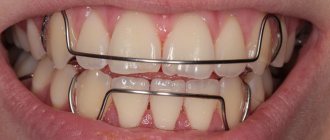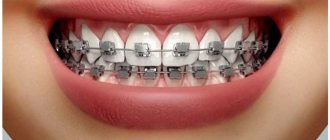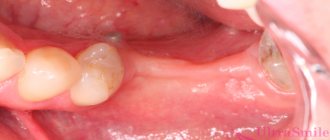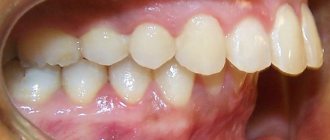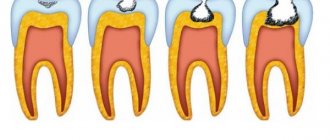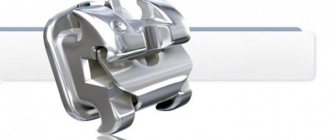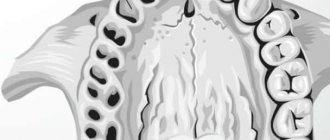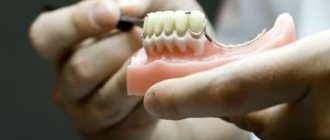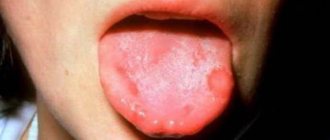April 11, 2020 Last revised: November 27, 2020 Bite correction
Vestibuloplasty is a surgical method of correction of the oral cavity, in which, as a result of the redistribution of soft and mucous tissues, the space between the lip and the dentition deepens. The main purpose of such an operative procedure is to shift the internal contours of the mouth and the gum attachment zone, reducing and completely eliminating ischemia and excessive tension of the soft tissues and attached mucous surface of the gums, and improving blood circulation.
Vestibuloplasty of the lower jaw: what kind of operation is it?
Each person has his own individual structure of the oral cavity and jaws, and some people may experience a clear lack of space between the lip and dentition. This lack of space causes excessive muscle tension in this area, which is fraught with the development of a variety of dental diseases and pathologies. Vestibuloplasty surgery is designed to help eliminate the defect of excessive muscle tension.
The procedure of vestibuloplasty is carried out in dentistry and during the manipulations, the specialist surgically expands the space between the teeth and lip, shifting the muscle fibers in the desired direction. Most often, vestibuloplasty of the lower jaw is performed; less often, the procedure is prescribed for the maxillary region.
Reviews
A large number of people who have undergone vestibuloplasty are satisfied with the results. Some of them note only short-term discomfort during the rehabilitation period.
We invite you to leave your feedback on this technique in the comments to this article.
In conclusion, we recommend watching a video of a real operation:
If you find an error, please select a piece of text and press Ctrl+Enter.
Tags mandibular vestibuloplasty
Did you like the article? stay tuned
Indications and contraindications for vestibuloplasty of the lower jaw
Mandibular vestibuloplasty can be performed for a number of reasons. Sometimes surgery is prescribed as an effective measure to prevent certain pathologies, in some cases - to treat existing diseases. Vestibuloplasty is also used in pediatric dentistry, as well as before prosthetics and implantation in adult patients.
The range of indications for mandibular vestibuloplasty includes the following conditions:
- Metabolic disorders in bone tissue.
- Speech therapy problems.
- The need to gain access to the root part of the teeth.
- For high-quality orthodontic treatment, implantation, prosthetics. In the last two options, preliminary vestibuloplasty of the lower jaw will allow achieving maximum stability and fixation of implants and dentures in the area of manipulation.
Vestibuloplasty is also used to eliminate aesthetic defects and to prevent periodontal diseases. However, in addition to the indications, vestibuloplasty also has a fairly extensive list of contraindications. It is not performed if the patient has chronic blood diseases, diseases of an oncological or mental nature, or osteomyelitis. These restrictions are permanent, but there are also temporary contraindications to mandibular vestibuloplasty. For example, the patient’s tobacco and alcohol addiction, multiple caries, poor oral hygiene, chemotherapy.
Temporary contraindications can be eliminated and after this the patient can undergo vestibuloplasty of the lower jaw. The decision on the advisability of surgery is always made by the dentist treating the patient. When deciding on the need for vestibuloplasty in a particular case, the specialist will carefully examine the patient’s condition, conduct a series of studies and then advise whether to use vestibuloplasty or look for an alternative to this procedure.
Vestibuloplasty in Moscow
from 7850 rub. More about prices
We have been working since 1994
we are one of the first to open private dentistry in Moscow
Best materials
only new and modern equipment for dental treatment
Free
consultation with a dentist
Payment options
- cash
- plastic cards
- cashless payments
Doctors' experience
- with great experience
- graduated
- conference participants
When should you consider vestibuloplasty?
Vestibuloplasty effectively alleviates the patient’s condition; you can resort to it by:
- cosmetic indications: pronounced aesthetic disturbances and cosmetic defects of the face caused by the small vestibule of the oral cavity;
- bite correction;
- increased tone of the mental muscles;
- correction and preparation of orthodontic mucous tissues before extensive treatment, prosthetics, implantation;
- disturbance of sound production and complicated phonation of some sounds due to the small oral vestibule;
Vestibuloplasty in Moscow before and after photos of our patients
Photo before
Photo after
Photo before
Photo after
Photo before
Photo after
Techniques for vestibuloplasty
In modern dentistry, mandibular vestibuloplasty can be performed using different technologies, each of which has its own unique features. We will take a closer look at the nuances of performing vestibuloplasty using different methods below, having examined in detail each of the existing methods.
Vestibuloplasty according to Clark
Vestibuloplasty using the Clark method is the simplest option for this type of operation. However, this technology is traditionally used for vestibuloplasty in the maxillary region. When performing manipulations, the surgeon dissects the soft tissue between the teeth and lip and slightly peels off the mucous membrane. This action will allow you to achieve the desired change in the position of the muscle fibers.
Edlan-Meicher method for mandibular vestibuloplasty
This technique is used exclusively for vestibuloplasty of the lower jaw, and experts recognize it as the most effective. Excision of tissue is carried out in the longitudinal direction, and peeling of the mucous membrane is performed in the perpendicular direction. Some of the tissue is moved inward or to the side, unnecessary parts are carefully removed. The vestibuloplasty operation is completed by fixing the muscles with sutures.
Schmidt technique for mandibular vestibuloplasty
This method of performing vestibuloplasty of the lower jaw allows you to avoid affecting the periosteal tissues when performing manipulations. An incision is made along the bone and a piece of tissue is pulled inward and firmly fixed.
Glickman technology
The use of this technique makes it possible to perform vestibuloplasty on large areas of the oral cavity. The tissue incision is made strictly in the area of the lip junction, and then the flap obtained as a result of detachment of the mucous membrane is sewn to the vestibule of the oral cavity.
Possible complications
Possible complications include:
- Bleeding gums . In this case, special compresses are used and hemostatic agents are prescribed.
- Reduced sensitivity of formations at the ends of nerve fiber processes . Happens when nerve endings are touched during a cut with a scalpel. As a rule, the injury goes away on its own within six months. In order to restore sensitivity as quickly as possible, doctors recommend resorting to exercises for the muscles of the maxillofacial area and physical therapy.
- Formation of keloid scars . The formation depends on the quality of the vestibuloplasty technique. The problem is eliminated by repeated surgery to remove scar tissue.
- A fistula forms at the junction of the mucous membrane of the cheek and the gum . The pathology occurs in the area where the surgical suture is applied and is eliminated after the thread is removed.
- Swelling of soft tissues . This complication always accompanies surgical interventions and disappears on its own after complete healing of the wound area.
Tunnel vestibuloplasty - a gentle method of vestibuloplasty
This method is considered universal, since it allows effective vestibuloplasty of the lower and upper jaw. The technique is a gentle technology and is often used to perform vestibuloplasty of the lower jaw in very young patients, for example, to solve orthodontic and speech therapy problems. Less trauma is achieved by making several small incisions instead of one large one.
A modern method of performing vestibuloplasty is surgery using a laser. The use of a laser in vestibuloplasty of the lower jaw can significantly reduce the pain of the procedure, as well as its traumatic nature for patients. The actions performed by a specialist will be similar to manipulations with other methods, but the process uses innovative instrumentation, which ensures maximum precision and accuracy of the incisions, and thanks to this, the mandibular vestibuloplasty operation takes place with less discomfort for the patient, and the wound heals much faster after it.
It is important to understand that the effectiveness and positive effect after vestibuloplasty depend largely not on the choice of technique, but on the qualifications and professionalism of the dentist who will perform the operation. In our Vanstom dental clinic, vestibuloplasty is performed by surgeons of the highest level of qualifications, and therefore by contacting us, you are guaranteed to receive a service of the European level of quality and a 100% positive result after vestibuloplasty!
Preparation and stages of vestibuloplasty
In order for mandibular vestibuloplasty to be effective and without complications in the future, you should properly prepare for the operation. Before vestibuloplasty, the oral cavity must be thoroughly cleaned, and six hours before the operation, exclude solid foods from your diet and do not take medications other than those prescribed by your doctor. If you take medications prescribed by specialists from other fields of medicine, be sure to inform your dentist about this before vestibuloplasty surgery!
The correct psychological attitude is also important: there is no need to be afraid of the operation of vestibuloplasty of the lower jaw, it goes quickly enough, and anesthesia helps to remove all painful sensations during surgical procedures. If you cannot cope with anxiety before vestibuloplasty on your own, discuss the upcoming operation with your doctor!
The vestibuloplasty operation is divided into several main stages:
1. Introduction of an anesthetic drug, the choice of which is made by the doctor and on the basis of a detailed study of the individual characteristics of the case and the patient’s body. Proper selection of anesthetics can relieve the patient from acute pain during mandibular vestibuloplasty.
2. The lower jaw vestibuloplasty itself is performed using one of the methods described above. On average, a vestibuloplasty operation will take about one hour.
3. Upon completion of all manipulations, a bag of dry ice is applied to the area of vestibuloplasty, which the patient will need to keep on the jaw for at least a quarter of an hour. You can also apply ice at home, this will help relieve swelling and reduce pain after vestibuloplasty of the lower jaw.
Swelling and pain for some time after vestibuloplasty are considered normal. Taking anesthetics prescribed by your doctor will help reduce the intensity of pain. The specialist will also give you the most detailed advice on post-operative care and oral hygiene. It is important to follow all the dentist’s recommendations after vestibuloplasty of the lower jaw exactly, otherwise various kinds of complications cannot be ruled out!
Rehabilitation activities
Depending on individual characteristics, patients after vestibuloplasty may experience numbness and loss of sensitivity of the oral mucosa, swelling, and discomfort when speaking. During the rehabilitation period, you can get rid of these manifestations by doing the following:
- rinse your mouth with a doctor-recommended mouthwash after each meal. Light brushing of teeth with a soft brush on the 4-5th day after surgery;
- following special dietary recommendations. The main diet should consist of pureed, soft dishes, purees. Alcohol, spicy, sour, hot and solid foods, dairy products are prohibited (they can provoke the formation of unnecessary bacteria)
- simple, regular, restorative exercises: external, light massage of the skin covering the operated area, touching the area of the vestibule of the mouth with the tip of the tongue, periodically pouting the lips for at least 2 minutes/up to 5 times a day;
- Regular visits to the doctor to monitor recovery and regenerative processes. Clinical control 3.6 months after the intervention.
Possible complications after vestibuloplasty of the lower jaw and the cost of the procedure
The main causes of complications after mandibular vestibuloplasty are non-compliance with doctor’s recommendations and poor oral hygiene. The main possible complications after vestibuloplasty include bleeding, low sensitivity, scar formation, and severe swelling of the gums. If the listed phenomena do not go away after vestibuloplasty for several days, seek the advice of a specialist to eliminate the risk of developing inflammatory processes.
You can find out the exact cost of lower jaw vestibuloplasty only after a consultation and examination with a dentist in Moscow - Vanstom. The price of the procedure is influenced by a variety of factors, which will be studied by a specialist from our dental clinic, after which he will be able to tell you the cost of the service. Vestibuloplasty of the lower jaw at Vanstom dentistry is quality, efficiency and a guarantee of 100% positive results!
Vestibuloplasty in Moscow: price
| — Vestibuloplasty | 6500 rub. |
| — Primary surgical treatment with suturing | 1000 rub. |
| — Manufacturing of a protective plate | 8000 rub. |
| — Collection of connective tissue graft | 4000 rub. |
| — Infiltration and intraligamentary anesthesia | 350 rub. |
| — Conduction anesthesia | 400 rub. |
View price list

